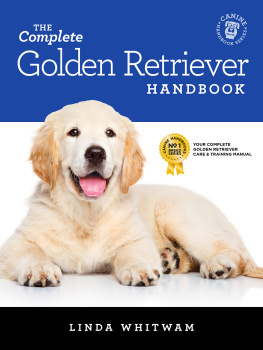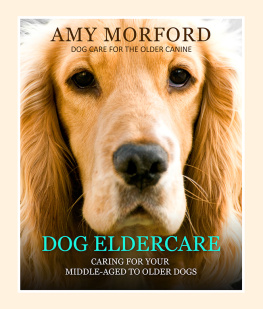The Complete Healthy Dog Handbook
The Definitive Guide to Keeping Your Pet Happy, Healthy & Active
Betsy Brevitz, D.V.M.
WORKMAN PUBLISHING NEW YORK
Copyright 2004, 2009 by Urbanhound, LLC
Interior illustrations copyright 2004, 2009 by Kip Carter
All rights reserved. No portion of this book may be reproducedmechanically, electronically, or by any other means, including photocopyingwithout written permission of the publisher. Published simultaneously in Canada by Thomas Allen & Son Limited.
Design by Lisa Hollander with Sophia Stavropoulos
Front cover photograph by GK Hart/Vikki Hart/Getty Images
Back cover photographs by Hans Wretling/age fotostock (dog) and Shutterstock (ball)
Library of Congress Cataloging-in-Publication Data is available.
eISBN 9780761157090
Originally published as The Hound Health Handbooknow revised and updated. Some of the material in this book is adapted from the website www.urbanhound.com, or from the book Urbanhound: The New York City Dogs Ultimate Survival Guide, by Nina Munk and Nadia Zonis.
Workman books are available at special discounts when purchased in bulk for premiums and sales promotions as well as for fund-raising or educational use. Special editions or book excerpts can be created to specification. For details, contact the Special Sales Director at the address below.
Workman Publishing Company, Inc.
225 Varick Street
New York, NY 10014-4381
www.workman.com
To dogs, who love with their whole hearts; and to my home pack, whom I love doggedly.
Contents
PART 1
PREVENTIVE HEALTH CARE
CHAPTER 1
Choosing a Healthy Dog or Puppy
CHAPTER 2
Raising a Healthy Puppy
CHAPTER 3
Keeping Your Adult and Senior Dog Healthy
PART 2
COMMON CANINE ILLNESSES
CHAPTER 4
Allergies, Itching, and Other Skin Diseases
CHAPTER 5
Vomiting, Diarrhea, and Other Digestive Ailments
CHAPTER 6
Worms, Fleas, Ticks, and Other Creepy-Crawlers
CHAPTER 7
Mental Health and Behavior Problems
CHAPTER 8
Eye and Ear Diseases
CHAPTER 9
Bones, Joints, and Arthritis
CHAPTER 10
The Heart and Circulation
CHAPTER 11
Colds, Coughs, and Other Respiratory Problems
CHAPTER 12
Diabetes and Other Endocrine Diseases
CHAPTER 13
Seizures and Other Neurological Diseases
CHAPTER 14
The Bladder, Kidneys, and Reproductive Tract
CHAPTER 15
Blood and Lymph Disorders
CHAPTER 16
Cancer and Cancer Treatment
CHAPTER 17
When the End Is Near
PART 3
QUICK REFERENCE
CHAPTER 18
First Aid Basics and Poison Control
CHAPTER 19
ABC Guide to Injuries and Emergencies
PART 4
HEALTHY DOG RESOURCES
APPENDIX A
Pet Health Insurance
APPENDIX B
Alternative and Complementary Medicine
APPENDIX C
Finding a Veterinary Specialist
APPENDIX D
Helpful Websites for Dog Owners
Foreword to the New Edition
In the four years since the original Hound Health Handbook was published, notable events, trends, and discoveries have changed dog ownership and veterinary medicine alike. The two most significant events were Hurricane Katrina in August 2005 and the widespread pet food contamination of spring 2007. Hurricane Katrina rapidly increased the numbers of dogs being moved from one area of the country to another, or even from one country to another, in search of homes. When dogs relocate, so do diseases. Heartworm disease is much more prevalent in the Northeast now that so many southern and Gulf Coast dogs have found homes here, and vets everywhere have had to expand their diagnostic lists of usual suspect diseases to include newcomers from other parts of the country. In 2007, pet food recalls shook consumer trust, raised awareness of whats in pet food and where it comes from, and created tremendous interest in home cooking for dogs and cats.
Trends that have influenced the canine world include the skyrocketing popularity of designer dog breeds; the increased availability of such once-rarefied procedures as CT and MRI scans, joint replacement, and radiation therapy for cancer; and the rising cost of veterinary care. Designer dogs have raised and sometimes dashed consumer expectations, provided lots of work for vets due to their inherited diseases, and raised profits for puppy mills. The spread of high-tech care means that almost anywhere in the country, you can now spend thousands of dollars diagnosing and treating a dogs illness or injury. You can, but should you? Financial pressures are affecting practically every dog-care decision these days. The current economic downturn has forced many dog owners to postpone or forgo preventive health care measures, and added to the difficulty of deciding what to do if their dogs get sick.
On a brighter note, the past four years have provided some handy new tools for the veterinary toolbox. An anti-vomiting drug that can be used for car sickness and other stomach upsets, a new injectable antibiotic that lasts for two weeks, and a vaccine against malignant melanoma that significantly increases dogs survival time after tumor removal are a few of the useful new innovations.
Of course, the essentials of our relationships with dogs have not changed in the past four years, and I take great comfort in that. People remain devoted to their dogs, and their dogs to them. We veterinarians remain committed to giving your animals the best possible care, and are fully aware of the economic pressures facing so many of us these days. As for the future, I look forward to taking care of dogs and cats for a good many years to comelearning, growing, and appreciating the pleasures that animals bring to our lives.
Betsy Brevitz, D.V.M.
January 2009
Introduction
In my first job as a veterinarian, I was a nervous wreck. I loved medicine, I loved animalsso why was it all so overwhelming? My boss coddled me by having the front desk schedule only three appointments an hour for me, even though the more experienced vets at our practice had four. Still, my clients got backed up in the waiting room, and I was frazzled.
I had 20 minutes to talk to each owner about the animals symptoms, do a complete physical exam, make at least a tentative diagnosis and an initial plan for testing and treatment, and then explain to the owner what I wanted to do and why. I would have dismissed that pace as impossible, except that I saw my colleagues keeping up, or at least not falling as far behind as I did.
Fortunately, follow-up phone calls gave me more time to get things right. When the evenings appointments were over, I would sit down with a stack of medical files and phone messages and call clients to discuss test results or simply to ask how their animal had been doing in the few hours since Id seen him. During those phone calls, I sometimes discovered that a client hadnt really understood why I wanted to do a particular blood test or diagnostic procedure. So I would explain it all again, trying even harder to make sense. Often people had questions they had thought of after theyd left the office. Sometimes I had questions Id thought of only after theyd left. Many times, in talking again with an animals owner, I would hear a detail or focus on a symptom I had missed during the initial exam. I relied on those phone calls to explain whatever I hadnt made clear, to add any information Id forgotten to give, and to make sure Id understood all the owners concerns.
ANIMALS AND THEIR PEOPLE
No one becomes a veterinarian for the money or the glamourthe profession doesnt offer much of either. For the most part, people decide to become veterinarians because theyre interested in medicine and enjoy working with animals. But on that heady day when senior veterinary students first walk into an exam room on their own, it becomes clear to themif they hadnt realized it beforethat they are going to be working with people, too. Those dogs, cats, and guinea pigs dont amble into the veterinary hospital on their own. Attached to every animal is a human being, and the vet has as much to learn from listening and talking to the person as she does from examining the patient.






